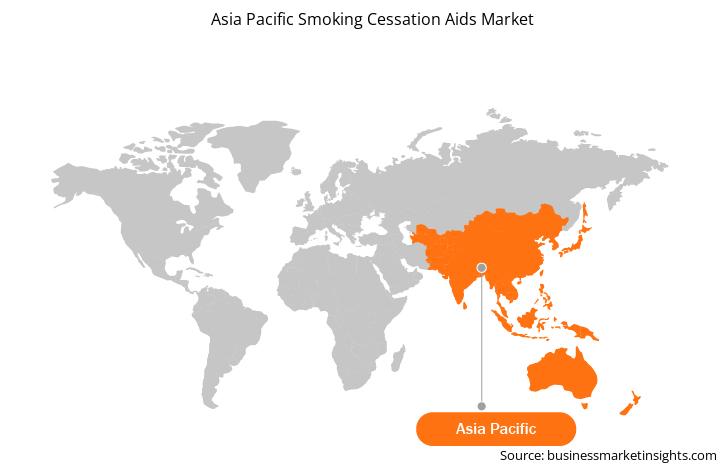Smoking cessation lowers the risk of cancer and other serious health problems. Some products contain nicotine as an active ingredient and others do not. Counseling, behavior therapy, medicines, and nicotine-containing products, such as nicotine patches, gum, lozenges, inhalers, and nasal sprays, may be used to help a person quit smoking. They are regulated through the FDA’s Center for Drug Evaluation and Research, which ensures that the products are safe and effective and that their benefits outweigh any known associated risks.

Strategic insights for the Asia Pacific Smoking Cessation Aids provides data-driven analysis of the industry landscape, including current trends, key players, and regional nuances. These insights offer actionable recommendations, enabling readers to differentiate themselves from competitors by identifying untapped segments or developing unique value propositions. Leveraging data analytics, these insights help industry players anticipate the market shifts, whether investors, manufacturers, or other stakeholders. A future-oriented perspective is essential, helping stakeholders anticipate market shifts and position themselves for long-term success in this dynamic region. Ultimately, effective strategic insights empower readers to make informed decisions that drive profitability and achieve their business objectives within the market.

| Report Attribute | Details |
|---|---|
| Market size in 2021 | US$ 5,015.08 Million |
| Market Size by 2028 | US$ 14,753.04 Million |
| Global CAGR (2021 - 2028) | 16.7% |
| Historical Data | 2019-2020 |
| Forecast period | 2022-2028 |
| Segments Covered |
By Product
|
| Regions and Countries Covered | Asia-Pacific
|
| Market leaders and key company profiles |
The geographic scope of the Asia Pacific Smoking Cessation Aids refers to the specific areas in which a business operates and competes. Understanding local distinctions, such as diverse consumer preferences (e.g., demand for specific plug types or battery backup durations), varying economic conditions, and regulatory environments, is crucial for tailoring strategies to specific markets. Businesses can expand their reach by identifying underserved areas or adapting their offerings to meet local demands. A clear market focus allows for more effective resource allocation, targeted marketing campaigns, and better positioning against local competitors, ultimately driving growth in those targeted areas.

The Asia Pacific smoking cessation aids market is expected to reach US$ 14,753.04 million by 2028 from US$ 5,015.08 million in 2021; it is estimated to grow at a CAGR of 16.7% from 2021 to 2028. Key factors that are driving the growth of this market are increasing number of campaigns to reduce smoking and tobacco dependence and introduction of new smoking cessation aids across world. However, steeping costs for development of nicotine replacement therapies are likely to restrain the market growth in the future years to some extent.
The huge patient population in developing countries of Asia Pacific is generating demand for new products and therapies for smoking cessation. In addition, Southeast Asian countries has one of the highest smoking populations in the world. The population can lead to the high incidence of chronic diseases in Asia Pacific, which is a key factor increasing the number of clinical trials in Asia. Thus, the introduction of new smoking cessation products in terms of therapeutic and medical device aids in the emerging economies is likely to provide significant growth opportunities to players involved in the global smoking cessation aids market in coming years. The number of clinical trials conducted in Asia Pacific is more than those in the US or Europe owing to low operational costs, large patient recruitment potential, contract research organizations growth, favourable regulatory environment, and better clinical trials capacity and quality. The substance and tobacco abuse treatment industry are getting competitive every consecutive year with the introduction of new and innovative therapies by the market players for smoking cessation aids. In addition, medical devices such as nicotine-free e-cigarettes and vapes are being launched by market players at local and regional levels. Thus, the consistent launch of new and innovative smoking cessation aids would become a prevalent trend in the smoking cessation aids market in the coming years.
Asia Pacific countries are expecting to witness a huge challenge due to the outbreak of COVID-19. Restrictive measures such as central lockdown and trade limitations have been taken to control the spread of COVID-19. The world health organization (WHO) have been evaluating new research constantly, and it states that there is a positive relation between tobacco use and nicotine use, helping COVID-19 patients to get well. For increasing risk for COVID-19, smoking is the major cause of underlying health conditions. However, there is currently insufficient information to confirm any link between tobacco or nicotine in the prevention or treatment of COVID-19. Hence, the impact of the COVID-19 pandemic on smoking cessation aids market is low in the Asia Pacific region.
Based on product, the Asia Pacific smoking cessation aids market is segmented into nicotine replacement therapy, drugs, electronic cigarettes, and others. In 2021, the electronic cigarettes segment is likely to hold the largest share of the market and is expected to grow at the fastest rate in the coming years.
Based on end user, the Asia Pacific smoking cessation aids market is segmented into hospital pharmacies, online channel, retail pharmacies, and other end users. The retail pharmacies segment is likely to hold the largest share of the market in 2021, whereas the online channel segment is anticipated to register the highest CAGR of the market during the forecast period.
A few of the primary and secondary sources associated with this report on the Asia Pacific smoking cessation aids market are the India Brand Equity Foundation (IBEF), National Health Service (NHS) and World Health Organization (WHO).
The Asia Pacific Smoking Cessation Aids Market is valued at US$ 5,015.08 Million in 2021, it is projected to reach US$ 14,753.04 Million by 2028.
As per our report Asia Pacific Smoking Cessation Aids Market, the market size is valued at US$ 5,015.08 Million in 2021, projecting it to reach US$ 14,753.04 Million by 2028. This translates to a CAGR of approximately 16.7% during the forecast period.
The Asia Pacific Smoking Cessation Aids Market report typically cover these key segments-
The historic period, base year, and forecast period can vary slightly depending on the specific market research report. However, for the Asia Pacific Smoking Cessation Aids Market report:
The Asia Pacific Smoking Cessation Aids Market is populated by several key players, each contributing to its growth and innovation. Some of the major players include:
The Asia Pacific Smoking Cessation Aids Market report is valuable for diverse stakeholders, including:
Essentially, anyone involved in or considering involvement in the Asia Pacific Smoking Cessation Aids Market value chain can benefit from the information contained in a comprehensive market report.